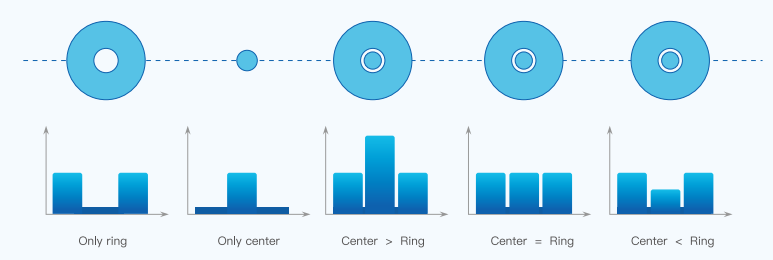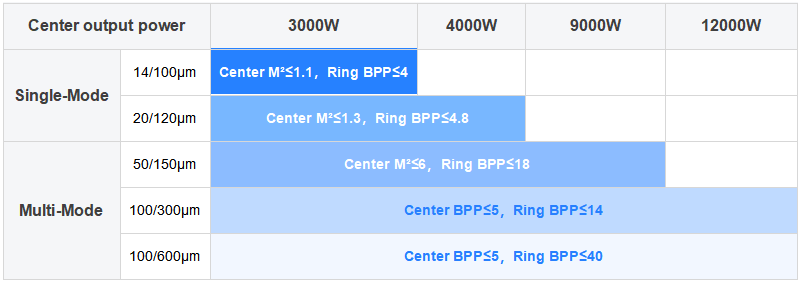Open a new energy vehicle “perspective”, from the charging infrastructure to the three power systems, the amount of copper has reached 80 kg to 120 kg, nearly four times more than the amount of copper used in traditional fuel vehicles. Copper, with its excellent electrical conductivity, thermal conductivity, ductility and corrosion resistance, has become an important functional material for new energy vehicles, power batteries, energy storage batteries and a new generation of electronic information products. However, when traditional lasers weld these materials, they are prone to the problems of high spatter and unstable welds. With the global manufacturing industry moving towards high-end and precision, the processing of highly anti-corrosive materials has been transformed from an industry pain point to a key indicator for measuring the core competitiveness of enterprises.
As we all know, under the same power conditions, the smaller the core diameter, the higher the brightness, the stronger the equipment's anti-high-anti-reflective ability, the higher the evaporation threshold of the breakthrough material, the easier the material absorbs, and the processing of high-anti-reflective materials is easy to do. GW Laser, with its deep accumulation in the field of high-brightness fiber lasers, has specially developed the FRM Laser, which introduces a ring beam that surrounds the outside of the high-intensity center beam. The center beam is used to form the weld seam, and the ring beam is used to stabilize the melt weld pool, which can achieve welding very low spatter, no bursting point, no cracks, stable weld shaping, good consistency, and greatly improve the processing efficiency in the production and processing of new energy vehicles that use a large number of copper and aluminum and other highly anticorrosive materials.
FRM lasers can arbitrarily control the power size of center laser and ring laser, and can only open the center laser or ring laser, or both at the same time, forming three modes of normal spot, ring spot and composite spot, which can broaden the process window of various applications and optimize the production process, thus achieving better, faster and more stable welding.

GW Laser FRM lasers offer single-mode and multi-mode fiber lasers with a variety of core configurations for different processing needs. Single mode FRM lasers can achieve high productivity and high stability welding, suitable for electric vehicle welding and lithium battery welding applications. High-power multi-mode FRM lasers provide high dual-beam output power and are suitable for high-speed welding of structural parts.

Battery Pack
Battery sealing welding is an important process to ensure the safety and reliability of batteries, and is widely used in the manufacturing process of new energy batteries such as lithium batteries and liquid flow batteries.
For battery sealing welding, GW Laser's FRM laser creates beautiful, uniform and defect-free weld seams, which can effectively prevent electrolyte leakage and improve the sealing and reliability of the battery. In addition, the use of non-contact processing, small heat-affected zone, less damage to the internal structure of the battery, can be adapted to the sealing needs of complex shapes and small-sized parts, while easy to realize automated production.
Busbar Welding for Batteries
Whether cylindrical, square or flexible pack cells, the individual cells are connected via conductive busbars to form modules.
GW's FRM Laser adopts dual beam outputs. The high-brightness center beam delivers high energy density to shorten welding time and reduce heat input, and the independently controllable ring beam optimizes the molten pool and reduces spattering to ensure the quality of busbar processing. In addition, it can be paired with a high-performance galvanometer, which enables high-efficiency, high-dynamic performance welding, shortening production time and dramatically increasing throughput.
Electric Motor Manufacturing
Laser welding technology for flat wire motors is mainly applied to the winding forms of Hairpin (hairpin), X-pin (cross hairpin) and Umini-pin. Among them, the X-pin technology, with the elimination of the straight line segment, places higher demands on the welding process, including higher efficiency and lower heat input.
In flat copper wire welding, there are high requirements for porosity and welding quality. The core diameter ratio (center/ring 14/100) of FRM laser can effectively correct the shape of the keyhole, maintain the stability of the keyhole, further stabilize the molten pool, and reduce the welding defects, such as porosity and spattering, which can improve the welding quality and welding efficiency of flat copper wire.
New energy vehicles, energy storage and high-end manufacturing fields continue to rise in demand for efficient and precise processing of copper, aluminum and other highly anti-materials, to solve the traditional pain points such as spatter, weld instability and so on has become the industry's immediate needs. For the processing of copper, aluminum and other highly anticorrosive materials, the FRM laser of GW Laser can effectively solve the welding problems and achieve zero spatter, no porosity on the surface, stable depth of fusion, smooth and beautiful weld seams, and significantly improve the quality of welding. In the face of the harsh challenges of processing high-reflective materials, choose GW Laser - a professional, stable and trustworthy partner for industrial-grade laser processing.
 0
0
